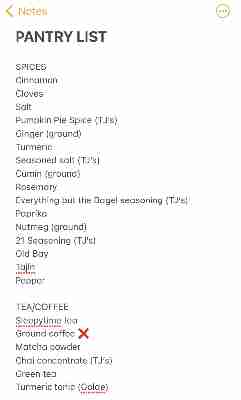
If I had a nickel for every time I bought a jar of spices at the grocery store, only to come home and realize I already owned a jar (or more!) of rosemary or paprika or [insert spice here]… well, I’d be able to buy at least another jar. And while I’ve always been good at jotting down a makeshift grocery list on my phone’s notes app, it’s almost always a very loose sketch of my pantry’s most-reached for snacks and ingredients. So when my friend recently told me how she approaches grocery shopping, I was both intrigued and inspired.
Instead of starting with a blank slate every week, she keeps a reverse grocery list and keeps a log of everything she has at home and/or has run out of.
Basically, the reverse grocery list functions like a pantry list : You can keep it on your phone, or if you want to share it with someone else, can create a living document on Google Docs or some other digital server.
Building your list is by far the most time-consuming part of the process. Depending on the size of your pantry , you’ll want to spend a weekend afternoon or a few minutes each day going through your pantry and writing down exactly what you have in stock. If the brand is important to you, you can note it in parentheses, and if you have duplicates, you might want to make note of that, too. Arrange your groupings in whatever matter makes sense for you — I have different categories for spices and herbs; tea and coffee; baking supplies; general cooking supplies like oils and vinegars; dry goods like beans and rice; and canned or jarred goods like soup, salsa, and enchilada sauce.
My friend also recommends creating a subsection for items that you keep regularly in the fridge — eggs, almond milk, and lemon juice concentrate are just some of the items on my “fridge list.”

How to Use Your Reverse Grocery List:
Once you build your list, it’s easy to maintain. If you run out of an ingredient as you go about your day, mark it on your pantry list. (I use emoji for an easy identifier.) Then, when you run to the grocery store, run to the list and replenish the items you’ve run out of if you know you’ll need them soon.
I built my reverse grocery list just before Christmas and New Year’s, and already it has saved me money. Though I’ve been trying to avoid last-minute grocery store runs in an effort to minimize my time outside of the home, I found myself at a Trader Joe’s at a time when there was no line in front. Rather than making a frenzied sweep of the store, I simply pulled out my list and got to work. (It’s a good thing, too: At the time, I was out of the store’s 21 Seasoning Salute, as well as their dried mango.)
You might still want to build a grocery list for ingredients you buy less frequently, or for the items you’ll need to build a week of meal-planning or even a special recipe you don’t often try. But it’s almost always better to be prepared — and now with two lists, you’ll be less likely to accidentally double up on that random jar of spices you can rarely get through in the first place.












